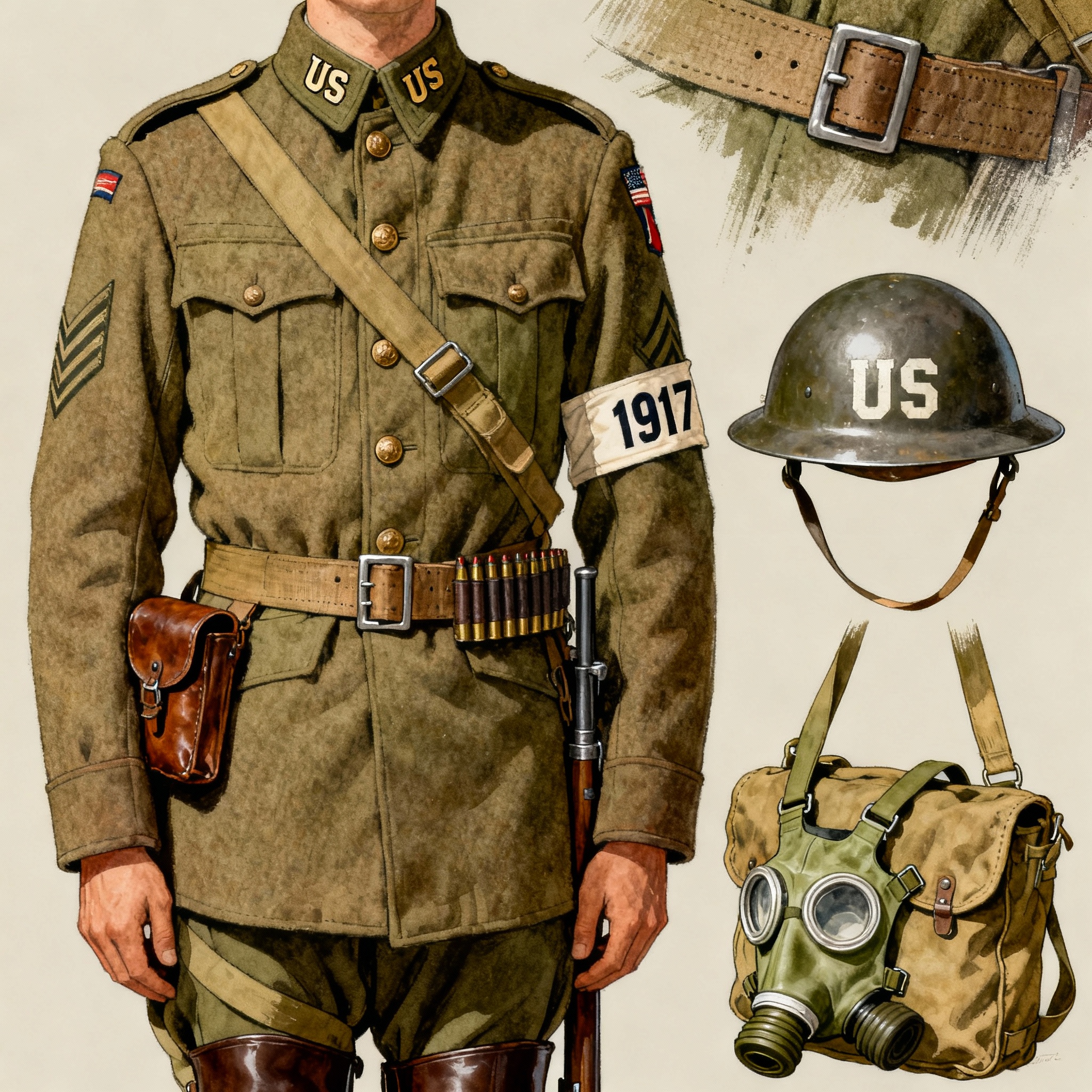
A Beginner’s Guide to WWI American Uniforms and Gear
Published on Oct 04, 2025
🔍 Introduction:
Did you know that over 4 million Americans served in World War I—and every one of them wore a uniform that told a story? Whether you're a military historian, collector, reenactor, or just fascinated by wartime gear, understanding World War One American uniforms gives you a window into the past that books alone can’t offer.
But with so many replicas, condition grades, and variations on the market, collecting or studying WWI uniforms can be confusing without guidance. This article breaks down everything you need to know—from tunics and trousers to Air Corps insignias—and gives you actionable tips, real examples, and trends that are shaping the hobby today.
What Makes World War One American Uniforms Unique?
The U.S. military uniform underwent a transformation during World War I. Unlike the elaborate European designs, American Army uniforms prioritised practicality and mass production—but still carried distinct identity and heritage.
Key Features:
- Wool tunics with stand-up collars
- Breeches and wrap leggings
- Branch-specific insignias (Infantry, Artillery, Engineers, etc.)
- "Doughboy" helmets introduced in 1917
- Early versions of air corps gear, including leather flying jackets and goggles
🧥 Understanding the American Army Uniform Tunic World War One
The American Army uniform tunic of World War One was both functional and symbolic.
🔍 Components of the Tunic:
- Color: Olive drab wool
- Pockets: Four-pocket design with scalloped flaps
- Buttons: Bronze buttons with the U.S. eagle insignia
- Rank and unit patches sewn onto sleeves
- Some featured wool-lined collars for colder climates
✅ Real-World Example:
Collectors often look for tunics with original unit patches, especially those from the 82nd Division or 1st Infantry Division, which fetch higher prices due to historical significance.
✈️ Spotlight: American Army Air Corps Uniforms World War One
Though the Air Corps were in their infancy during WWI, their uniforms were distinct.
What to Look For:
- Leather flying jackets
- Flight helmets with padded interiors
- Goggles made from brass and glass
- Insignias featuring wings and propellers
Tip:
Original Air Corps items are rare and valuable. If you're new to collecting, start with easier-to-find items like Air Service armbands or repro patches before investing big.
📦 Actionable Tips for Collecting WWI American Uniforms
Whether you want to display a full kit or just understand the history, start with these steps:
🧭 Step-by-Step Guide:
- Start Small: Begin with one item (e.g., a helmet or tunic).
- Buy From Reputable Dealers: Look for sellers with good reviews, references, and certifications.
- Use UV Light: Authentic WWI fabrics often glow under blacklight (cotton stitching vs. modern polyester).
- Look for Provenance: Items with soldier names, service numbers, or photos are more valuable.
- Preserve Properly: Use acid-free tissue and garment bags, and avoid direct sunlight.
⚠️ Common Pitfalls to Avoid
Even seasoned collectors get tripped up by fakes or poor preservation methods.
❌ Mistakes to Watch Out For:
- Buying "mint condition" WWI uniforms (be sceptical—these were worn in war).
- Confusing WWI and WWII American uniforms—differences can be subtle.
- Storing wool uniforms in humid conditions (risk of moths and mold).
- Overpaying for common items labelled as "rare".
📈 Current Trends in the World of WWI Uniform Collecting
As younger generations grow interested in historical reenactments and digital collections, new trends are emerging:
🔥 Hot Trends in 2025:
- 3D-scanned digital uniforms for virtual museums
- WWI-to-WWII comparative displays (WWI tunic next to WWII Ike jacket)
- High demand for American Army Air Corps uniforms World War One due to the rise of aviation-themed collections
- Growth in WWI replica uniform rentals for film, theatre, and YouTube channels
🧰 Tools & Resources for Beginners
📚 Books:
- “U.S. Army Uniforms of World War I” by Shelby Stanton
- “Doughboy to GI: U.S. Army Uniforms 1900–1945” by Kenneth Lewis
🛍️ Online Shops:
- At the Front
- Hessen Antique
- International Military Antiques (IMA)
- eBay (with caution)
👥 Forums & Communities:
- Reddit: r/MilitaryCollecting
- The Great War Forum
- Facebook groups for WWI Reenactors and Collectors
📸 Real-Life Example: Building a Display Collection
Tom, a WWI collector from Virginia, started with a simple American Army uniform tunic from World War One from his grandfather’s attic. Over five years, he built a full display with:
- Rifle and bayonet
- Campaign hat
- Trench boots
- Medals and discharge papers
He now showcases it at local history fairs and has inspired several young enthusiasts to start their own collections.
🧩 Comparing WWI and WWII American Uniforms
With 51% of collector interest now leaning toward World War II American uniforms, it’s helpful to understand key differences:
FeatureWWI Uniforms WWII Uniforms Colour | Olive Drab (darker brown-green) | Olive Drab #33 and later #7 (lighter)
Style | High-collar tunic, wrap leggings | Shorter "Ike" jackets, gaiters
Helmets | M1917 "Doughboy" style | M1 steel pot
Air Corps Gear | Leather, primitive oxygen gear | Advanced flight suits, radios
Knowing these differences helps avoid confusion when shopping or restoring pieces.
🎯 Conclusion: Preserve History with World War One American Uniforms
Whether you’re a curious newcomer or an experienced historian, exploring World War One American uniforms opens a door to a powerful era in American history. From American Army Air Corps uniforms from World War One to the classic wool tunic, each piece tells a personal and national story worth preserving.
Don’t just collect—connect. Visit a museum, join a reenactment, or create a display that inspires others to learn.
